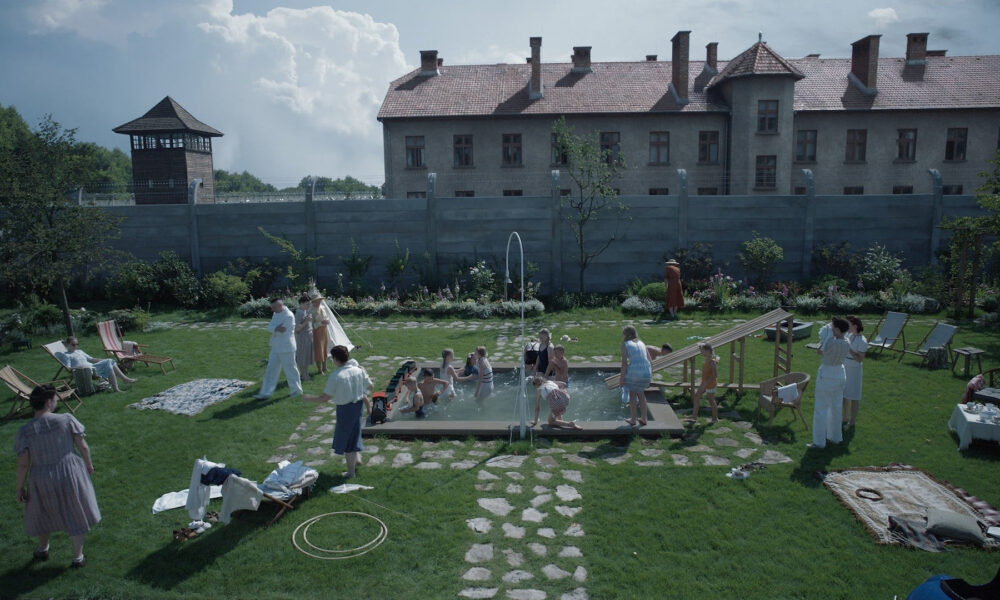Minor spoilers for The Zone of Interest
How would you depict an atrocity onscreen? What would you show, and perhaps more importantly, what wouldn’t you? In Jonathan Glazer’s new five-time Oscar-nominated film, The Zone of Interest, these choices are put at the forefront of the narrative. The result? Nothing short of cinematic greatness.
The film follows Rudolf Höss (Christian Friedel) and his wife Hedwig (Sandra Hüller) as they move through their seemingly monotonous daily lives. They attend picnics, swim in the river, celebrate birthdays, and read bedtime stories to their children—the picture of a happy nuclear family. However, something sinister looms beyond the walls of their garden. Never out of sight (or more accurately, out of earshot) are the smokestacks, gunshots, and screams from Auschwitz. Indeed, Höss is no ordinary father: He is the commandant of a Nazi death camp.
Though the film takes place directly outside of Auschwitz—the now-infamous curved barbed wire fence delimits the family’s garden—its interior is never shown. This is a stark departure from previous Holocaust dramas, such as Schindler’s List and The Pianist, which heavily feature concentration camps and Jewish ghettos. Instead, the camp acts as an unseen shadow over their daily lives. It infuses every action that they perform with the darkness of their complicity, without directly interfering in their “normalcy.” Here, the banality of evil is on full display.
The girls don’t go shopping; they get clothes delivered from “next door.” They don’t use compost to fertilize their garden; they use ash instead. The tension between the family’s actions and what they represent is visceral—nearly unbearable. It would be one thing if they didn’t know where their clothes and “garden fertilizer” came from; it’s another because they do. It is these innocuous moments that punctuate the film’s central drama, and Glazer makes sure that we are constantly reminded of just how terrible this ordinary family truly is.
The Zone of Interest is shot simply, with wide, still takes and a pale colour palette. But it works; dramatic flair has no place in this grim story. The film’s matter-of-fact visual style subtly reflects how the Holocaust’s horrors became normalized, bureaucratized, and clinical. Furthermore, this makes the moments which deviate from this style that much more impactful. After an important scene, Glazer holds a close-up of a rose for a little too long and a little too close for comfort. The bright red that fills the screen is a simple but powerful metaphor: No longer are roses beautiful and idyllic, instead they are sown from blood and hatred.
Glazer masterfully conveys utter horror and evil without ever explicitly showing it. One reason for his success is sound: Tarn Willers and Johnnie Burn engineer a quietly nightmarish soundtrack. Screams of agony and burning fires are a constant presence but somehow fade away after some time. You are lulled into complacency, only to be reminded of where the film takes place by a loud gunshot followed by a piercing shriek.
Like the visuals and sound, the Höss family simplifies and decontextualizes their day-to-day lives to make them more bearable. The parents do not explicitly mention the genocide happening on the other side of the wall, nor do the kids seem to understand what their father’s job truly consists of. Yet Glazer argues with vigour that the family’s hearts and souls are affected nonetheless—the poisonous deeds of their complicity affect them in ways that they cannot yet see.
In its final 15 minutes, The Zone Interest reaches new heights. Having set the scene in the previous hour and a half, Glazer then delivers the film’s most poignant and harrowing moment. His creative risks pay off in the end and elevate the story beyond a traditional Holocaust narrative. Given its disturbing subject matter, The Zone of Interest may not be a film you want to watch, but it is certainly one you need to watch.








